PUBLIC DOMAIN WORKS DONE FOR NASA.
These are
some of my works commissioned by various NASA facilities. They
are offered here to provide something like definitive digital
versions of such images, and unfortunately the NASA centers can
rarely do this. You paid for them and they're yours.
My work on this page only was created in the
public domain, elsewhere on my site I claim copyright on the artwork
and text.
I would like to encourage people who enjoy
this work to place the images on this page onto other sites for
further distribution rather than linking directly to my site,
so as to fairly distribute the bandwidth use. I have yet to temporarily
pull this page due to bandwidth issues, but I came close February
07!
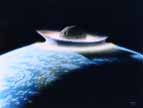 A planetoid plows onto the primordial Earth, during
the eons of time when conditions were ripe for the development
of life. It is possible that life of kinds unknown to us appeared
repeatedly only to be destroyed in collisions like this one which
could 'rework' the entire surface. Fortunately the average size
of debris declined sharply through geologic time, but the supply
of wayward rocks a few kilometers in size is by no means exhausted.
Of my hundreds of paintings this is the most widely seen example
on the web, a fact aided by the public domain nature of the work!
164K
A planetoid plows onto the primordial Earth, during
the eons of time when conditions were ripe for the development
of life. It is possible that life of kinds unknown to us appeared
repeatedly only to be destroyed in collisions like this one which
could 'rework' the entire surface. Fortunately the average size
of debris declined sharply through geologic time, but the supply
of wayward rocks a few kilometers in size is by no means exhausted.
Of my hundreds of paintings this is the most widely seen example
on the web, a fact aided by the public domain nature of the work!
164K
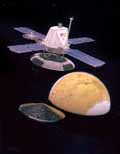
The Viking Orbiter spacecraft releases the
aeroshell clad lander near the 'high point' of it's orbit around
Mars. The planet is shown based on Mariner 9 photography, oriented
as it should appear during separation. Oil on canvas panel for
NASA Headquarters. 636K
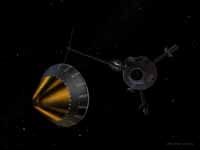
The Galileo Probe leaves the Orbiter
some 180 days before the encounter. Here is the full 4K file.
Digital painting for NASA Ames. 664K
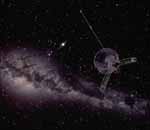
On ABC's 'Nightline' I heard a
report Pioneer 10 would try to image the Sun among the stars as
it crossed the orbit of Neptune. This turned out to be not true,
and I resolved to create such a view. The sky is accurately portrayed
and the Sun with its brighter planets are placed where they would
be in relation to the background. The spacecraft is based on hardware
photographs. Acrylic on board for NASA Ames. 560K
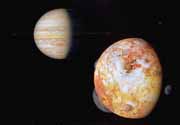
A series of paintings were commissioned by
Charles Kolhase of the Jet Propulsion Laboratory (JPL) depicting
highlights of each of the 4 Voyager outer planet encounters. Io
and it's volcanoes passes near Jupiter in a view actually seen
by the spacecraft. Computer generated line drawings of the planets
and stars were supplied to insure accuracy. Io is colored as it
appeared in preliminary color balancing attempts, it is actually
close to the color of powdered sulfur. Oil on illustration board
for JPL. 444K
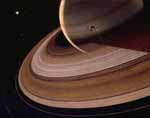
Voyager 2 at the moment of it's closest approach
to Saturn. The ring divisions were drawn on the board with a rapidograph
pen before the paint coats were applied! Earth is the blue 'star'
to the right of the Sun, below the Sun is crescent lit Titan.
Oil on illustration board for JPL. 528K
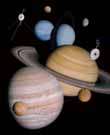
This painting was commissioned by JPL to commemorate
the outer planets mission of the successful pair of Voyager spacecraft.
Although done in traditional media, computer drawings were generated
as an aid to creating perspective rings of the proper scale for
each world, which also has one Moon each highlighted. Only distant
shots of Neptune were available at the time the work was done,
and the hypothetical 'ring arcs' are included as modeled from
earth based star occultation data. Acrylic on board for NASA,
JPL. 1MB
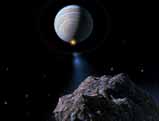
The view from a fragment of the Shoemaker /
Levy 9 comet which fell into Jupiter piece by piece over several
days in Late July 1994, around the 25th anniversary of Apollo
11. Acrylic on board for NASA Ames. 212K
For those of you reaching this page through
recent publicity concerning my space colony images you may find
my thoughts on space
colonies worthwhile.
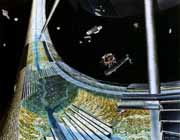
The assembly of the 'Stanford Torus', detailing
the proposed 'chevron shields' above the glass 'skylights'. The
interior is shown primarily hollowed out and heavily planted.
Most other depictions show the colony crammed with lavels of high
density housing. Ugh. Oil on board for NASA Ames. 1.1MB

The 1975 NASA Ames/Stanford University
Summer Study worked out the broad engineering requirements for
a toroidal shaped space colony design. This painting used the
design, but I refused to fill the interior with the 'shopping
mall gone mad' clutter of other drawings. Again the challenge
of sustaining something like a closed ecosystem was a theme I
wanted to emphasize. This design became known as the 'Stanford
Torus'. Oil on board for NASA Ames. 656K

One of my earliest Space Colony
paintings was based on the giant 'Model 3' cylindrical habitats
envisioned by Gerard O'Neill. I imagined the clouds forming at
an 'altitude' around the rotation axis. At this time the scene
is bathed in the ruddy light of all the sunrises and sunsets on
Earth at that moment as the colony briefly enters the Earths shadow,
out at the L5 Lagrangian point where stable locations are easily
maintained. Oil on canvas panel disposition unknown. 336K

 A planetoid plows onto the primordial Earth, during
the eons of time when conditions were ripe for the development
of life. It is possible that life of kinds unknown to us appeared
repeatedly only to be destroyed in collisions like this one which
could 'rework' the entire surface. Fortunately the average size
of debris declined sharply through geologic time, but the supply
of wayward rocks a few kilometers in size is by no means exhausted.
Of my hundreds of paintings this is the most widely seen example
on the web, a fact aided by the public domain nature of the work!
164K
A planetoid plows onto the primordial Earth, during
the eons of time when conditions were ripe for the development
of life. It is possible that life of kinds unknown to us appeared
repeatedly only to be destroyed in collisions like this one which
could 'rework' the entire surface. Fortunately the average size
of debris declined sharply through geologic time, but the supply
of wayward rocks a few kilometers in size is by no means exhausted.
Of my hundreds of paintings this is the most widely seen example
on the web, a fact aided by the public domain nature of the work!
164K








